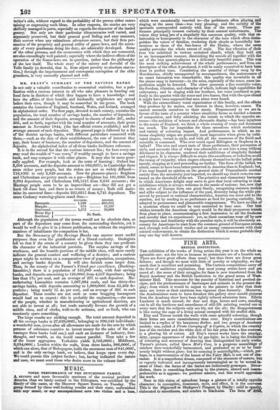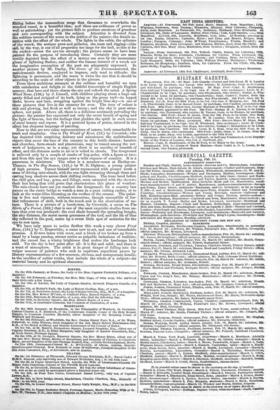FINE ARTS.
BRITISH INSTITUTION.
THE exhibition of the works of living artists this year is on the whole an agreeable one; not the less so because its pretensions are of a humble sort. There are fewer great efforts than usual; but then there are fewer great failures; and though we meet with little of novelty or originality, we find much that is excellent and promising. The Cartoon competitions carry off the fever of ambitious aspirations, that most young artists have and get cured of : the scene of their struggles for fame is now transferred from the Royal Academy and the British Institution to the grand arena of Nifeet- =luster Hall. This accounts for the paucity of historical and poetioaLda- signs, and the predominance of landscapes and animals in the present dis- play; from which it would be unjust to the painters to infer that their aims are lower or their exertions less vigorous than formerly. Moreover, the Academicians seem to have forsaken this gallery since unsold pictures from the Academy show have been rightly refused admission here. Edwin Landseer is much missed; for deer and dogs, horses and cows, standing out in all the hardness and smoothness of still-life painting, remind one at every turn that the subjects only are his, not the art: the disappointment is like seeing the cage of a living animal occupied with his stuffed skin.
Etty and Turner enrich the walls with some splendid colouring, though their forms are more unsatisfactory than ever. Etty's contributions are limited to a replica of his beauteous Bather, and two groups of Academy models: one, called A Pirate Carrying of a Captive, in which the swarthy hue of the ravisher and the white skin of his fair prize form a fine contrast, is a glowing bit of colour. All Etty's recent works have the smudgy, dirty, opaque appearance of studies by gas-light: he is losing the freshness of colouring and accuracy of drawing that distinguished his early works. Turner's picture, called Queen Mab's Cave, is a gorgeous assemblage of rainbow tints wonderfully harmonized, and graduated so as to be lumi- nously bright without glare: but its meaning is unintelligible,—which, per- haps, in a representation of the haunt of the Fairy Mab, is not out of cha- racter. It is a magnificent dream, composed of the elements of nature, but so vaguely indicated and incongruously intermingled as to be unreal in- stead of ideal: the forms of the fairies are ludicrously grotesque. Never- theless, there is something fascinating in the picture, absurd and incom- prehensible as it appears: we perforce admire, and fain would appretiate the work.
Near to this vision of splendour hangs a picture of a totally opposite character: in conception, treatment, style, and effect, it is the converse. This is the Shipwreck in Shakspere's Tempest, by Danby: solid to opacity, elaborated to smoothness, and sombre to blackness. The form of-'Alf, flitting before the tremendous surge that threatens to overwhelm the wrecked vessel, is a beautiful idea ; and there are evidences of power as well as painstaking: yet the picture fails to produce emotions of grandeur and awe corresponding with the subject. AttentiOn is diverted from the sublime terrors of the scene to the artifice of the painter; the details in- terfere with the effect of the whole. The lights in the cabin, the splinters of the wreck, the antique prow and galleries, the mast and rigging-(the sail, by the way, is out of all proportion too large for the hull, as this is for the rocks)-arrest the eye too strongly; the picture seems to have been painted for the purpose of introducing them. Certainly they are more vividly depicted than the effect of a stormy sea seen by the momentary gleam of lightning flashes; and neither the human interest of a wreck nor the imaginative conception of the poet are adequately expressed. In another picture by Mr. Darby, The Grave of the Excommunicated, the melodramatic devices, employed to impress, only tend to ridicule: the lightning is permanent, and the moon is twice the size that it should be according to the scale of other objects in the picture. From these ambitious attempts at the sublime and beautiful we turn with satisfaction and delight to the faithful transcripts of simple English scenery, that here and there charm the eye and refresh the mind. A Spring Wood Scene, (139,) by J. Linnell, with children playing about a huge oak newly felled and stripped of its bark, lying on the green turf-its lopped limbs, brown and bare, straggling against the bright blue sky-is one of those pictures that live in the memory for ever. The tone of colour is rich and glowing, but fresh as well as sunny; and the sky is pure atmo- sphere, not paint. Above all, there is a delicious sentiment pervading the picture: the painter has expressed not only the sweet breath of spring and the light of heaven, but the feelings that gladden the spirit in such scenes of rural beauty and repose. It is a pastoral hymn of praise, uttered in the silent but eloquent language of painting.
Near to this are two other representations of nature, both remarkable for truth and simplicity. One is The Weald of Kent, (13,) by Creswick; who has depicted with surprising delicacy and minuteness the multitudinous objects that cover the face of the country in this fertile district: hamlets and churches, farm-steads and plantations, may be traced among the net- work of hedgerows, as in a map; yet there is no sacrifice of breadth of effect, and the distance melts in air or is veiled in clouds. The foreground is relieved only by a couple of stacks of hop-poles, with a figure or two; and from this spot the eye ranges over a wide expanse of country. It is a panorama in miniature. The other is a meadow-scene at Henley-on- Thames, in The Hay Season, (151,) by W. E. Dighton; a. young painter of high promise. Turner himself never represented with greater truth a mass ordriving rain-clouds, with the.sun-light streaming through them and casting long shadows across their shifting surfaces. The trees bend before the chill gust, and hay, grass, and foliage, seem saturated with the shower; their hue being that cold green that characterizes this phase of weather. The rain-clouds have not yet reached the foreground; for a country lass pauses on the rustic bridge to watch a man in a punt cutting rushes, or to look at the water-lilies blooming on the surface of the stream. The paint- ing is free and vigorous, without mannerism, though susceptible of fur- ther refinements of skill, both in the touch and in the observation of nal tam There is a picture of a beech-tree, by Creswick, a scene on The Skirts of a Forest, (369,) that is one of the most exquisite studies from na- ture that ever was produced: the cool shade beneath the spreading boughs, the airy distance, the moist mossy greenness of the turf, and the bit of blue shy reflected in the pool, make up a sweet little spot of seclusion for the exm to rest upon. We have only space to notice further this week a very clever Frost Meng, (191,) by C. Bramwhite; a name new to art, and one of remarkable promise. A fir-tree laden with snow, and a block of ice broken up from a canal by a barge passing, attract notice as palpable imitations of realities; and the sunset has a wintry brightness that makes the landscape look cold. Yet the sky is but paint after all: it is flat and solid; and there is a want of atmosphere. The artist is in great danger of falling into the vulgar manner of painters who seek to captivate superficial gazers by illusory representations of a few common, obvious, and unimportant details; to the sacrifice of nobler truths, that include the whole of a subject-its material beauty and its spiritual character.



























 Previous page
Previous page